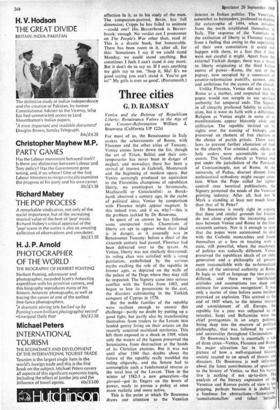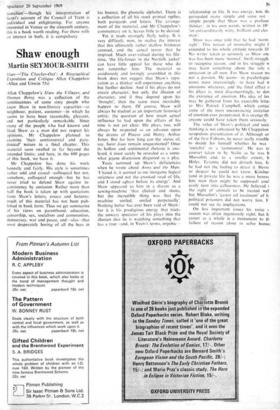Three cities
G. D. RAMSAY
Venice and the Defense of Republican Liberty: Renaissance Values in the Age of the Counter-Reformation William J. Bouwsma (California UP 122s) For most of us, the Renaissance in Italy evokes the achievements of Rome, with Florence and the other cities of Tuscany. Venice comes lower down the list, though the art of Titian, Bellini and their con- temporaries has never been in danger of neglect, and nowadays there has been a revival of interest in Gabriel, Monteverdi and the beginning of modern opera. But Venice seemingly produced no equivalent to the Florentine champions of republican liberty, no counterpart to Savonarola, Machiavelli or Guicciardini: as Burck- hardt observed a century ago, in the realm of political ideas Venice by comparison with Florence might appear stagnant. Is this indeed true, and if so, why?—this is the problem tackled by Dr Bouwsma.
In quest of an answer he has followed some unexpected trails. Champions of liberty are apt to appear when their ideal is in danger, as it assuredly was in Renaissance Tuscany: before a third of the sixteenth century had passed, Florence had been delivered over to the tyrant. At Venice, liberty was not similarly threatened; its ruling class was satisfied with a smug patriotism, embellished by the curious myths exalting the role of the republic in former ages, as depicted on the walls of the palace of the Doge where they may still be inspected. The Signory came into serious conflict with the Turks from 1463, and began to lose its possessions in the east, the disasters culminating in the Turkish conquest of Cyprus in 1570.
But the noble families of the republic were resilient enough to answer this challenge—partly no doubt by putting up a good fight, but partly also by transforming themselves from traders, to the Levant into landed gentry living on their estates on the recently acquired mainland territories. This left them exposed to a shock in 1509, when only the waters of the lagoon preserved the Serenissima from destruction at the 'hands of its Christian enemies. But it was not until after 1560 that doubts about the future of the republic really troubled the ruling oligarchy, and the Senate had to contemplate such a fundamental reverse as the total loss of the Levant. Then in the winter of 1582-3 a new generation—the giovani—got its fingers on the levers of power, ready to pursue a policy at once more realistic and more active.
This is the point at which Dr Bouwsma draws our attention to the Venetian interest in Italian politics. The Venetians, somewhat as bystanders, professed to deplore the catastrophe of 1494, when invaders from the north established themselves in Italy. The response of the Venetians to the extinction of liberty at Florence veered from a feeling that owing to the superiority of their own constitution it could not happen with them, to a fear that if they were not careful it might. Apart from the external Turkish danger, there was a threat to liberty originating at the third Italian centre of power—Rome, the seat of the papacy, now occupied by a succession of counter-reformation pontiffs, earnest, able and ambitious for the causes of the church.
Unlike Florence, Venice did -not look to Rome as a mother, and suspected that the popes would not scruple to use spiritual authority for temporal 'ends. The Signory in all sincerity professed fidelity to catholi- cism, but it wore its faith with a difference. Religion at Venice might in some of its manifestations appear blatantly civic and utilitarian. The republic insisted on its rights over the naming of bishops, and preserved an element of free election in the choice of parish priests. There were laws to prevent further alienation of land to the church. For criminal acts, clerks in holy orders were accountable to civil courts. The Greek church at Venice was put under the jurisdiction of the Patriarch of Constantinople, not of Rome. At the university of Padua, discreet dissent from ecclesiastical orthodoxy might escape atten- tion. When the Pope called for tighter control over heretical publications, the Signory protested the needs of the Venetian printing industry. After all, had not St Mark a standing at least not much lower than that of St Peter?
Dr Bouwsma is surely right in arguing that these and similar grounds for friction do not alone explain the increasing cool- ness between Venice and Rome in the later sixteenth century. Nor is it enough to state that the popes were accustomed to deal with the Catholic monarchies and found themselves at a loss in treating with a state, still powerful, where the machinery of politics was radically different. Venice preserved the republican ideals of an older generation and a philosophy of govern- ment irreconcilable with the re-formulated claims of the universal authority at Rome. In logic as well as language the two parties differed, and there were 'antithetical attitudes and assumptions too deep and intimate for conscious recognition'. It was only a matter of time before some incident provoked an explosion. This arrived at the end of 1605 when, to the intense interest and astonishment of all Europe, the republic for a year was subjected to an interdict. Sarpi and Bellarmine were the chief protagonists in an angry polemic, biting deep into the marrow of political philosophy, that was followed by courts and universities throughout Christendom.
Dr Bouwsma's book is essentially a tale of three cities—Venice, Florence and Rome. Its major attraction lies in the vivid picture of how a well-organised historic society reacted to an epoch of threats and disasters. Dr Bouwsma is well informed about the latest contributions of specialists to the history of Venice, so that his narra- tive is nothing if not up-to-date. His analysis of the literary expression of the Venetian and Roman points of view is less gripping, perhaps because it is dulled by a fondness for abstractions—'historicism `constitutionalism' and (alas) `jurisdic-
tionalism'—though his interpretation of Sarpi's account of the Council of Trent is individual and enlightening. For anyone interested in Venice or the sixteenth century, this is a book worth reading. For those with an interest in both, it is compulsory.









































 Previous page
Previous page